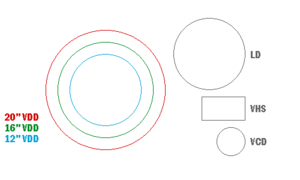Video Delivery Disc
 12-inch VDD in 1983 | |
| Media type | video playback media |
|---|---|
| Capacity | 20 min. monochrome (20-inch) 45 min. colour (16-inch) 60 min. colour (12-inch) |
| Read mechanism | stylus |
The Video Delivery Disc is a video storage format and playback system developed by Boradcasting Corporation of Themiclesia, whereby video could be distributed and replayed on common television sets. The physical medium was similar to, and developed from, the phonograph record, but VDD discs had much denser grooves and were read by a stylus detecting electric capacitance rather than vibration. The format was originally designed for broadcasting, but in development BCT later repositioned the format for home viewing of television shows, theatre, and cinema.
The VDD was first conceived in 1955 by Mark Nya, a BCT engineer, but only authorized for development in 1963. Playable discs were demonstrated in 1968 when the discs could hold 10 minutes of monochrome video. BCT promised an 1970 release, which was achieved but not without severe compromises. The recording density was improved several times after release, but compatibility with existing players was maintained with upgrades to styli. Sales of VDD machines continued until 1990, and discs were made until 1994.
Formats
20-inch
The 20-inch disc was the first VDD format released for public consumption in 1970 but post-dates the 16-inch in development. Engineers were troubled by the short recording times achieved on the 16-inch and, faced with a deadline the company imposed, resorted to increasing the size of the disc to increase recording time. The four extra inches in the disc's diameter allowed more than a 50% improvement in recording time. 20-inch audio discs were used as early as 1905 in Casaterra and were actually issued by the BCT in 1909 but were entirely obsolete by 1972. Because the recording density of the 20-inch disc was lower than the 16-inch and 12-inch versions, it did not require protection against dust; however, a felt sleeve was used to protect the large disc against scratches and drops.
The 20-inch disc could hold 10 minutes of monochrome video per side, and both sides were typically used to create a 20-minute playback. This format was suited to shorter television programmes, many of which occupied 30-minute blocks on the broadcasting schedule. Only 20 minutes was required because 10 minutes of the 30-minute block was used for advertisement. A separate audio disc was bundled with the video disc to be played on a separate record player. The two discs were manually synchronized. The 20-inch disc was phased out in 1981.
16-inch
The 16-inch disc was launched in 1974 and was capable of holding 25.5 minutes of colour video and audio per side. This format was designed to record hour-long television programmes, which consisted of 45 minutes of programming and 15 minutes of advertisements on most broadcasters.
12-inch
Players
BCT consoles
The first players manufacted by BCT were standalone "video delivery consoles" housed in cabinets, not unlike a fancy phonograph from the period. The consoles were all designed to house the 20-inch discs until the late 80s, when 20-inch discs, which carried monochrome video, were deemed obsolete. Several video delivery consoles were designed with two superimposed players: the video player was located on the lower shelf so as to shield the disc from dust, the higher shelf supporing the audio disc player. With the footprint of a piece of furniture, the lower space was often hollow to accommodate a collection of discs. Newer designs in the 80s were much more economical with their use of vertical space, some being table-top models, though the need to accommodate 20-inch discs constrained player to that minimum size.
In 1981, BCT introduced a miniaturized version of the console, labelled the T-1000, that played only the newest 12-inch discs. From that point, the three-digit T-series consoles were compatible up to the 20-inch disc, while the four-digit ones could only play the 12-inch discs.
Third-party players
Starting in 1979, BCT partnered with other firms to produce players.
Sales
The VDD was the centrepiece of the Video Delivery Service that BCT started offering in 1970. The VDS system allowed users to select past programmes whose rights BCT owned and have them delivered–on the VDD. Subscribers paid a monthly charge for the service and an additional fee per programme. The discs were physically posted to the subscriber's home and, after a given period, to be returned by post. In 1971, the first full year after the system's release, 4,240 subscriptions were signed, and this figure increased to 60,000 by 1974. However, the VDS plateaued after 1974, as the playback machine itself was also rented for a fee.
In 1972, BCT began negotiations with film studios regarding the release of films on the VDD. Early negotiations were hampered studios' speculation that releases on VDD would somehow harm commercial interests, but BCT was more willing to compromise on royalty payments in this regard, as the availability of films on the VDS would only enhance its appeal.
